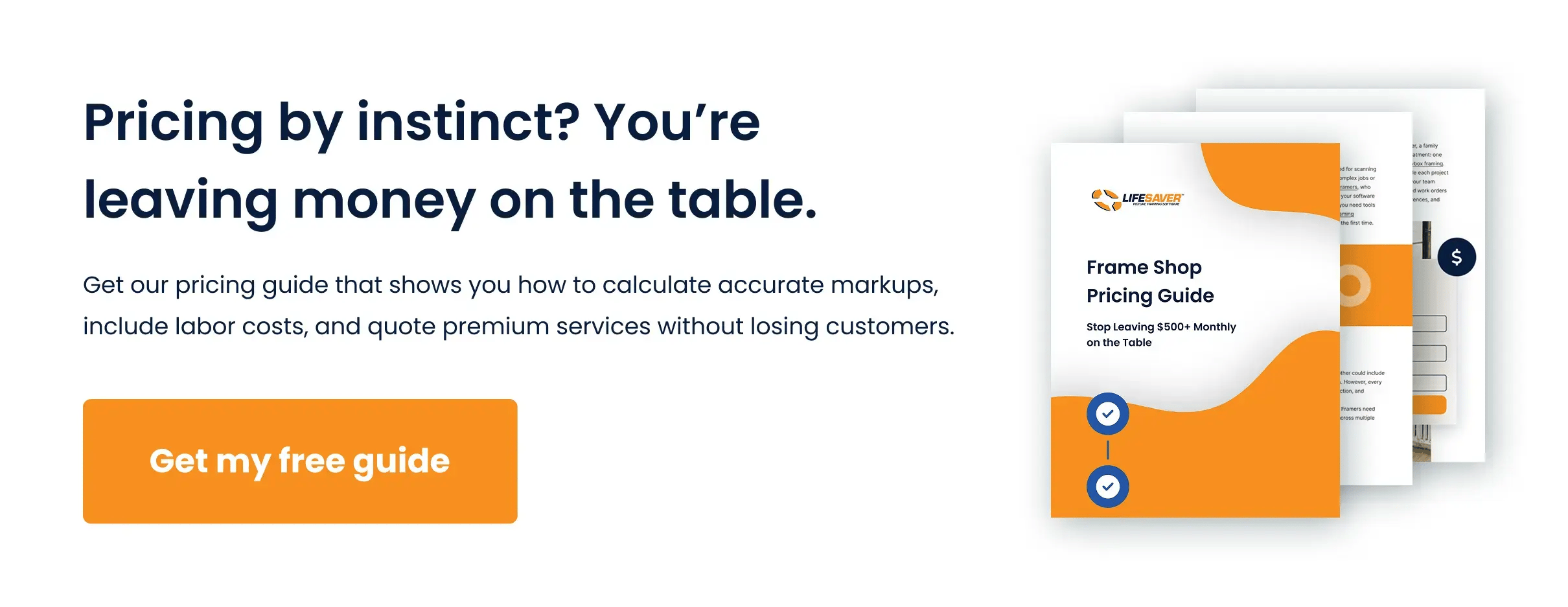
What’s a memory worth? For your customers, it might be a wedding photo, a championship jersey, or a one-of-a-kind print they’d never replace. For your shop, it’s time, skill, and materials that don’t come cheap.
But pricing custom framing isn’t as simple as slapping on a markup. If the price is too low, you lose profit. With a price too high, customers walk. And when no two jobs are alike, you need a strategy that reflects your craftsmanship and helps customers feel confident in what they’re paying for.
In this post, you’ll learn five retail pricing strategies to keep your shop profitable, build customer trust, and accurately price every custom order.
1. Use Cost-Plus Pricing To Cover Your Bases
Cost-plus pricing is the gold standard for keeping things simple and profitable. You total up the cost of materials, labor, and overhead, then tack on a profit margin — the amount you want to earn for your work. It’s one of the easiest and most reliable ways to price custom framing.
Here’s how to put it into action:
- Add up all material costs: Include moulding, matboard, glazing, backing, and hardware.
- Track labor time per job: Factor in design, cutting, fitting, and cleanup.
- Include overhead: Consider rent, utilities, packaging, and point of sale (POS) software.
- Decide your markup: Choose a margin that reflects your level of service — many framers start at between 55% and 65%, but can go as high as 500%!
Use this method when you want clear, consistent pricing with built-in profit. Your customers won’t see the math, but they’ll recognize the value when the price reflects the quality.
2. Create Tiered Pricing Options for Different Buyers
Not every customer is after premium moulding or eco-certified materials. Many just want something clean, simple, and budget-friendly. Tiered pricing gives them options and allows you to meet different needs without cutting into profits.
Here’s how to build pricing tiers that work across your product lines:
- Offer “good, better, best” packages: Use different vendors to source moulding, matting, and glazing across three price levels.
- Let customers self-select: Give virtual previews with price ranges up front so customers feel in control.
- Explain the value at each tier: Focus on what’s included, not what’s missing.
- Use signage or digital displays: Create wall charts or countertop guides to help customers compare pricing at a glance.
This retail pricing strategy works best for frame shops that want to maintain high-quality craftsmanship while offering something for every budget.
3. Anchor Pricing With One Premium Option
Choosing the right frame can feel intimidating, especially when customers aren’t sure what quality framing should cost. Price anchoring is a strategy where you showcase a premium option first, making your midrange choices instantly feel more reasonable without lowering the price.
Here’s how to steer customers toward the right choice:
- Display a high-end example near your bestseller: Use upgrades like museum glass, a fillet, or archival mounting to make your standard option feel like a sensible middle ground.
- Train staff to explain the upgrades: Highlight the longevity, prestige, or limited edition status of products you want to move more of.
- Position midtier frames as a “smart buy”: Use language like “most popular” or “best value.”
- Rotate your anchor pieces: Try seasonal themes or new arrivals to keep displays fresh.
Anchoring helps customers feel satisfied about their frame selection. They walk away with a piece that protects their memory, and you get paid for the time, tools, and craftsmanship that brought it to life.
4. Bundle Products for More Predictable Profits
Framing often includes specialty mats, UV glass, mounting hardware, and hanging wire. Instead of pricing each piece separately, create bundles that simplify the process and increase your average ticket.
Try these retail pricing strategy tips for bundles:
- Package common combinations: Build sets like a “Poster Package” with moulding, foam core backing, and standard acrylic glazing.
- Build seasonal or themed bundles: Introduce offers like a “Grad Frame Special” or “Holiday Memory Shadowbox.”
- Name your bundles creatively: Tap into emotion, occasions, or humor to make each offer memorable.
- Offer limited-time pricing: Create urgency and drive excitement with short promotions or countdowns.
Bundles make it easy for new customers to say “yes” — no guesswork, just a ready-made price that simplifies their decision.
5. Use Psychological Pricing To Influence Decisions
How you present prices can influence customer choices even more than the numbers themselves. Psychological pricing uses subtle tactics to make options feel clearer and more attractive.
Use tips like these to drive customer purchases:
- Use charm pricing: List a frame package based on the 99-end pricing rule. Listing $199 instead of $200, for instance, will make customers feel like they’re getting a better deal, even if the difference is negligible.
- Lead with your highest-priced option: Start with the most expensive moulding or glazing choices to make everything else look more reasonable by comparison.
- Break out upgrades like glass or mounting: List premium features as separate, optional line items — “museum glass, $15” feels more manageable than simply seeing a total in the hundreds or thousands.
- Reward full payment: Offer a small discount, like 5% off, for paying upfront to gently push customers to commit to the purchase while improving your cash flow.
Use these tactics to guide customers toward the right choice, increase order size, and make your pricing feel more inviting.
Tools To Help You Manage and Adjust Pricing
If you’re not tracking it, you’re guessing. To make these pricing strategies stick, you need the right tools — and it all starts with your POS system.
Here’s how your store’s POS software can help:
- Apply quick-pricing templates: Save custom pricing templates so you don’t have to create new ones from scratch for future orders.
- Monitor costs in real time: Track materials and labor as you work, using live inventory syncing to see exactly what each project costs you, down to the last detail.
- Generate profit-focused reports: Run reports by frame style, promotion, or package to spot what’s bringing in the most revenue, and where your pricing might need a second look.
- Automate price adjustments: Set up automatic pricing changes for sales, bundles, and seasonal promotions.
If your POS system makes pricing or job tracking harder than it should be, it might be time for a change. Look for a system built for frame shops, not generic retail stores. When your tools match how you work, it’s easier to price jobs correctly, keep track of orders, and give customers a better overall experience.
Retail Pricing Strategies That Support Your Frame Shop’s Success
Pricing your work shouldn’t be a guessing game. When you know your costs and present clear choices, customers say yes with confidence — and you protect your bottom line.
LifeSaver POS software takes the stress out of applying retail pricing strategies. With built-in features for framing visualizations and quotes, work order tracking, bundles, and custom settings tailored to your materials and labor, you can accurately price every order. Whether launching a new collection or running a promotion, it’s all at your fingertips on one easy-to-use dashboard.
Want to make pricing one less thing to worry about? Get a free trial of LifeSaver and see how it can support your framing shop’s success.

May 6, 2025 4:30:00 AM





